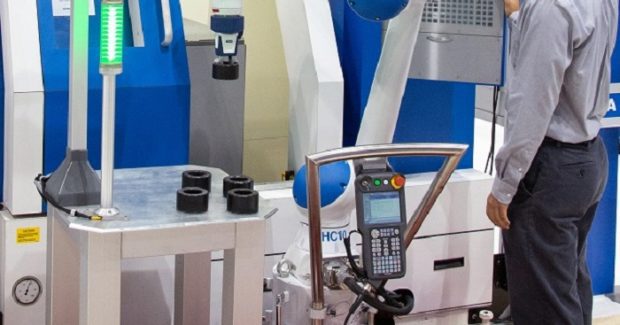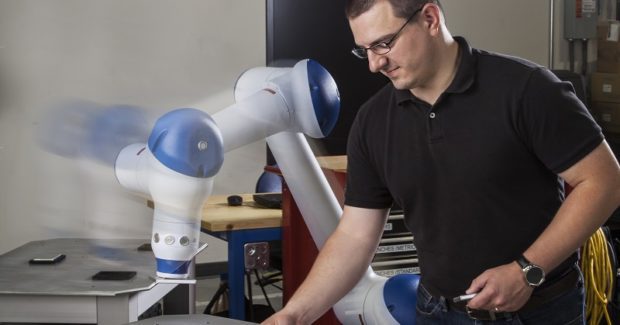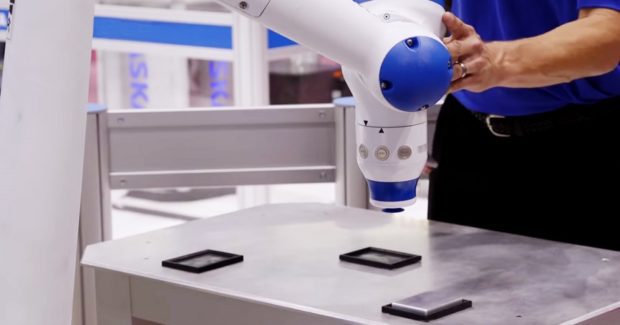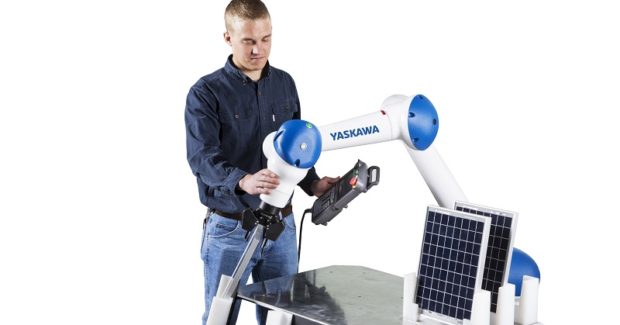What Does “Collaborative” Really Mean?
Human-robot collaboration is changing manufacturing operations by helping shops deal with competitive pressures and a lack of skilled labor, but it is not a “one size fits all” solution. Before you invest, consider the different forms of robotic collaboration and how they apply to your entire application.
Posted: May 28, 2019
From welding to trimming and handling to sorting, robots are highly capable of performing dull, dirty and dangerous tasks. While traditional industrial robotic automation is still a viable option for a wide variety of applications today, new market dynamics and technological breakthroughs have pushed manufacturing to a turning point. The increase in competitive pressure to accommodate product individualization and shorter product life cycles – on top of a growing talent shortage – is prompting leaders to invest in Industry 4.0 technologies to enhance operations and foster growth.1 At the same time, companies are turning from centralized to distributed manufacturing systems (DMS) to manage the uptick in manufacturing complexity. Regionally dispersed production facilities, intertwined with workstations that are managed by empowered employees and coordinated by smart technologies, are providing the flexibility manufacturers need to lower supply chain costs and fulfill unique consumer demands.
HUMAN-ROBOT COLLABORATION
A key piece of the puzzle for dealing with competitive pressures and distributed manufacturing systems is the presence of human-robot collaboration (HRC), where a robot – enabled by special technology to work collaboratively – shares a common workspace with a human operator to efficiently carry out defined tasks. The foundation for future intelligent production, HRC is quickly changing manufacturing operations, especially for assembly. The most difficult and monotonous applications that were once performed manually can now be carried out by robots in an ergonomic and timely manner, freeing human workers to focus on value-added tasks that are more in line with their specific skill sets. When considering HRC, it is important to look at the entire application.
For example, decision makers that set out to buy a “collaborative” robot (in name) without consideration for payload, speed, etc. may be in for a surprise. Often an application will mandate the presence of a larger and faster industrial style robot that does not possess the “collaborative” title or inherent collaborative functionality. Does this mean that human-robot collaboration is off the table? Absolutely not! It just means that a different form of robotic collaboration may be in order, depending on an in-depth risk assessment by a qualified individual. When it comes to human-robot collaboration, there are three common forms:
- Coexistence – when a robot and human have separate working areas, but the human occasionally enters the robot work envelope. Human-robot interaction is not very frequent.
- Cooperation – when a robot and human have a shared working area and the human often enters the robot work envelope. However, both work on separate tasks.
- Collaboration – when a robot and human have a shared working area and the human frequently or constantly enters the robot work envelope. In this situation, the human closely interfaces with the robot.
MODES OF COLLABORATION
Most people today think a collaborative robot is simply a robot that can be used without safety fencing and can work alongside humans. While those things make the process collaborative, there are four types of robot modes (according to ISO 10218 standards) that enable collaborative operation:
- Safety Monitored Stop. Effectively removing the need to turn off or re-enable servo motors, this mode is for occasional human-robot interaction and can be utilized with all robots that are equipped with a Functional Safety Unit (FSU). Often used with a traditional industrial robot paired with a series of sensors or a laser scanner, this mode can detect human worker entrance into the monitored area, temporarily pausing robot movement until the person is clear. A popular method for re-stocking piece parts, Safety Monitored Stop improves operational efficiency.
- Power and Force Limiting (PFL). Eliminating the requirement for external safety sensors, PFL robots allow robot motion when a person is present within the robot work envelope. These robots are also the only ones that are inherently safe by design, meaning they can work with, or in close proximity, to human workers without additional safety devices or process interruption. Used for frequent human-robot interaction, PFL technology allows the robot to monitor external forces applied to its body and stops if the force exceeds a calculated safe threshold, protecting workers from potentially harmful contact situations. Best used on robots featuring a smooth pinch-less design, PFL can be combined with other modes of collaboration to improve safety and cycle time. This method is ideal for light assembly or machine tending tasks.
- Hand Guiding. A unique feature on certain robots that simplifies robot teaching, this mode enables a robot programmer to teach a program path to the robot by physically guiding the robot from point to point. Ideal for a basic pick and place jobs, this method is typically used on robots equipped with PFL technology. Similarly, some industrial robots that use additional sensing devices are equipped for Hand Guiding, enabling easy programming for some welding applications.
- Speed and Separation Monitoring. Ideal for environments where there is frequent human-robot interaction, this mode is used on PFL robots to increase cycle times, as well as on traditional industrial robots to streamline human-robot interaction. Eliminating costly door interlock systems, this mode employs the use of laser scanners, light curtains or vision systems to track human distance to the robot. In this situation, the robot works within a pre-defined safety zone and slows when a human worker approaches the monitored area. Common uses for this collaborative mode include loading jigs and removing finished products.
While each of these features by itself qualifies a robot as collaborative, testing and safety validation of any workcell design is a necessary and arduous task to ensure user safety.
MORE FLEXIBLE AND PRODUCTIVE WORK ENVIRONMENTS
While human workers remain central to manufacturing, implementing robots and Industry 4.0 technologies is benefiting manufacturing ecosystems around the world . . . so much so that a record high number of robot units were shipped globally last year.2 This has fueled a higher level of production efficiency and greater return on investment (ROI) throughout the manufacturing sector, especially for small- to mid-sized shops branching out into robotics and for larger OEMs with processes that could not be automated in the past. Safe and easy-to-use collaborative robots combined with smart technologies are the fastest growing segment of industrial robotics, bolstering efforts to enable a wider user group to adapt robotic technology on the factory floor.3 Decision makers that embrace these systems will not only increase process flexibility, they will also compliment worker talents to create a more productive work environment.4
References
- “Assembling a Strong Future: Industrials Outlook,” Deloitte, 2018.
- “Outlook on World Robotics Report 2019,” International Federation of Robotics (IFR), 2019.
- “The Landscape of Industrial Manufacturing and Warehouse Robots,” Design News, 2019.
- “Tech Trend 2019: Beyond the Digital Frontier,” Deloitte, 2019.




















